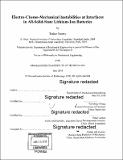| dc.contributor.advisor | Yet-Ming Chiang. | en_US |
| dc.contributor.author | Swamy, Tushar | en_US |
| dc.contributor.other | Massachusetts Institute of Technology. Department of Mechanical Engineering. | en_US |
| dc.date.accessioned | 2018-10-22T18:46:51Z | |
| dc.date.available | 2018-10-22T18:46:51Z | |
| dc.date.copyright | 2018 | en_US |
| dc.date.issued | 2018 | en_US |
| dc.identifier.uri | http://hdl.handle.net/1721.1/118732 | |
| dc.description | Thesis: Ph. D., Massachusetts Institute of Technology, Department of Mechanical Engineering, 2018. | en_US |
| dc.description | Cataloged from PDF version of thesis. | en_US |
| dc.description | Includes bibliographical references (pages 107-115). | en_US |
| dc.description.abstract | Inorganic solid-state electrolytes (SSEs) could replace flammable liquid electrolytes and improve the safety of Li-ion batteries. Furthermore, these SSEs could enable metal anodes, providing a significant improvement in cell-level energy density compared to the state-of-the-art. Recent improvements in the ionic conductivity of ceramic SSEs have invigorated commercial interest, prompting investigations into SSE/electrode interfacial properties. However, these investigations have revealed several challenges preventing the widespread adoption of all-solid-state Li-ion batteries. SSEs experience Li dendrite propagation and short circuit above a critical current density, similar to liquid electrolytes. While the pathways for Li penetration through a ceramic SSE such as grain boundaries and surface pores have been identified, the Li penetration mechanism is unclear. In addition, most SSEs experience detrimental redox reactions at the Li anode and 4 V cathode interface. The interfacial redox behavior of inorganic SSEs isn't well understood and requires further investigation. This thesis investigates the Li penetration mechanism into sulfide-based amorphous and polycrystalline SSEs, and garnet oxide-based single-crystal and polycrystalline SSEs. It also investigates the electrochemical redox behavior of sulfide-based SSEs. Experimental results show that Li can penetrate into single crystal SSEs devoid of grain boundaries and surface pores. Above a critical current density, the mechanical stress at a critically-sized Li-filled flaw tip at the SSE surface can breach the SSE fracture stress to initiate and propagate a crack through which Li penetrates the SSE, until a short circuit occurs. An electrochemo- mechanical model based on the Griffith theory of brittle ceramic fracture was developed, which relates the SSE fracture stress to SSE fracture toughness and surface flaw size. Experimental determination of the fracture toughness of sulfide-based SSEs revealed that these SSEs are compliant yet significantly more brittle than oxide-based SSEs. In addition, a cyclic-voltammetry based technique was developed to show that a sulfide-based SSE electrochemically decomposes to produce a redox-active interphase at the SSE/electrode interface. This is unlike in case of liquid electrolytes which decompose into an electrochemically irreversible interphase. | en_US |
| dc.description.statementofresponsibility | by Tushar Swamy. | en_US |
| dc.format.extent | 115 pages | en_US |
| dc.language.iso | eng | en_US |
| dc.publisher | Massachusetts Institute of Technology | en_US |
| dc.rights | MIT theses are protected by copyright. They may be viewed, downloaded, or printed from this source but further reproduction or distribution in any format is prohibited without written permission. | en_US |
| dc.rights.uri | http://dspace.mit.edu/handle/1721.1/7582 | en_US |
| dc.subject | Mechanical Engineering. | en_US |
| dc.title | Electro-chemo-mechanical instabilities at interfaces in al-solid-state lithium-ion batteries | en_US |
| dc.type | Thesis | en_US |
| dc.description.degree | Ph. D. | en_US |
| dc.contributor.department | Massachusetts Institute of Technology. Department of Mechanical Engineering | |
| dc.identifier.oclc | 1057268350 | en_US |
